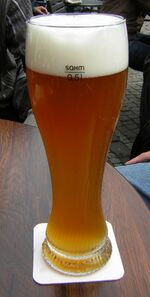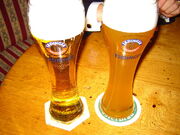
German Weißbier
For information on wheat beers in general, see Wheat beer.
Weißbier (literally translated as "White Beer," and so-called because it was at the time of its inception paler in color than Munich brown beer) is a Bavarian specialty brewed in which a significant proportion of malted barley is replaced with malted wheat. By German law, Weissbiers brewed in Germany must be top-fermented, making them ales.[1] Specialized strains of yeast are used which produce overtones of banana and clove as by-products of fermentation.[1]
Weißbier is well-known throughout Germany, though they are better known as Weizen outside Bavaria.
Varieties[]

Kristallweißbier (left) and Hefeweißbier (right) from Erdinger Weissbräu
- Hefeweiß: the yeast is not filtered out, giving the beer a cloudy appearance. Also known as Hefeweizen. (Literally: "Yeast Wheat".)
- Dunkelweiß (literally, "dark white"): Produced with dark malts and consequently darker in color, known for their malty, bread-like flavors. [1] Also known as Dunkelweizen (literally: "dark wheat") outside of Bavaria.
- Kristallweiß is filtered to remove the yeast, hence clear. Also known as Kristallweizen. (Literally: "Clear White".)
- Weizenbock is a strong variety usually enjoyed during colder months. To be labeled as such in Germany, the wort must be as least 16 Plato, making it a Starkbier. Usually unfiltered and bottle conditioned. Also known as Weizenstarkbier (literally: "strong wheat beer").
- Weizen Eisbock is a Weißenbock which has been concentrated using a freezing process to remove some of the water, and is named in analogy to its bottom-fermented counterpart, Eisbock.
Sensory profile[]
Weißbiers feature fermentation by-products such as esters (which lend fruity flavors and aromas), especially amyl acetate, reminiscent of bananas, and the phenolic compound 4-vinyl guaiacol, a metabolite of ferulic acid, which smells and tastes like cloves. Other phenolics sometimes found in Weißbiers evoke medicinal or smoky sensations, which some may find undesirable. The bittering level of most Weißbiers is close to 15 International Bitterness Units, a relatively low level. Hop flavor and aroma are typically low.[2][1]
The ester and phenolic aspects are produced by the special type of yeast, rather than the high fraction of wheat in the grain bill. Beers produced using the same yeast but with an all-malted barley malt bill, such as Dampfbier, have similar flavors and aromas.[3] The carbonation level can range from 5.5 grams per liter (approximately 2.7 volumes; slightly higher than that of most other German beers) to 7 grams per liter, or more. This produces a generous stand of foam, especially in light of the high protein content of wheat malt.[1]
Commercial examples[]
Some prominent commercial examples of Weißbier are produced by Paulaner, Erdinger, Schneider Weisse, Franziskaner, Rothaus, Hacker-Pschorr, Ayinger (Bräu Weisse) and Weihenstephan. Breweries in Austria also produce authentic examples, as do other breweries throughout the world.
Note that some beers produced in the United States labeled as "Hefeweizen" are quite different, and actually refer to a different type of beer. Nevertheless, some North American-brewed beers identifying themselves using the names above are reasonably accurate examples. These include beers from, among others, High Point Brewery in Butler, New Jersey and the Brooklyn Brewery.
Serving wheat beer[]
The traditional Weißbier glass has a rated capacity of one-half liter, plus additional room for the foam, is relatively slender, and tapers slightly towards the base.
Pouring Weißbier into the glass requires a bit of practice, as one has to avoid producing too much head. The two techniques are illustrated here, performed by industrial robots programmed by students of two Bavarian universities: This robot demonstrates the technique of holding the opening of the bottle close to the rim of the glass, while this robot uses the faster, but incorrect, immersion technique preferred by bartenders. Note the swiveling of the nearly empty bottle: This serves to pick up the yeast, an important part to unfiltered beer's complete taste. (It should be noted that the outside of the bottle should never come into contact with either the glass or the beer in the glass, as is may be contaminated with dirt, exhaust fumes etc.)
See also[]
References[]
External links[]
- WeizenWeb - wheat beer around the world
- GermanBeerGuide.co.uk - A British website's guide to Hefeweizen

|
This page uses content from Wikipedia. The original article was at Weissbier. The list of authors can be seen in the page history. As with Beer Wiki, the text of Wikipedia is available under the Creative Commons Attribution-Share Alike License 3.0. |